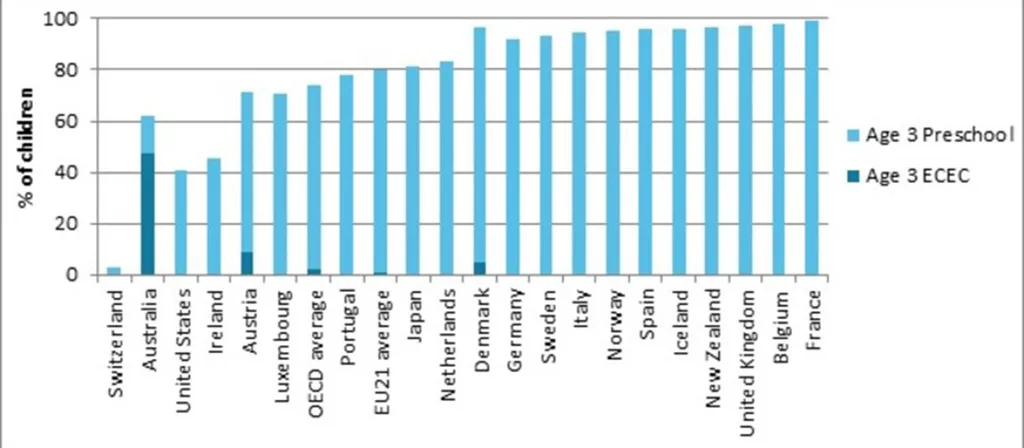Another report has been released showing the huge and long-term benefits kids – and therefore our nation -would get if universal access to preschool was provided to three-year-old children.
But at this stage in Australia only four-year-olds are guaranteed a place in pres-school. And the evidence is mounting globally that two years of preschool gives children the best start.
Victoria University has been conducting a study into the massive benefits associated with getting kids involved a year earlier. One of the key researchers, Dr Stacey Fox, is calling on the Federal and State governments to investigate making preschool available to all three-year-olds.
“”It means children are much more ready when they start school, they start school on a much more equal footing, it has flow on impacts to their NAPLAN scores, to their rates of Year 12 graduation,” she told the ABC.
Dr Fox also wrote the following article in The Conversation in September.
Time for Australia to provide preschool education for all three year olds?
Ireland has just become the latest country to make preschool programs available to all three year olds.
There is a clear move internationally towards delivery of two years of preschool, with early education being understood as a critical investment in human capital.
Who offers preschool to three year olds?
Many European countries, including France, Germany and Norway, have provided universal preschool for three and four year olds for decades. More recently, the UK and New Zealand have made moves to join them. And East Asian countries that consistently top education performance lists are rapidly gearing towards universal access for three and four year olds.
Australia has much lower levels of participation in ECEC (Early Childhood Education and Care) and preschool programs than our OECD peers.

Enrollment rates at age 3 in early childhood education, selected OECD countries, 2013 OECD. SOURCE: The Conversation
We currently provide universal access to one year of preschool in the year before children start school, delivered for 15 hours per week (or 600 hours per year). This is either free or subsidised, depending on which state you live in.
Is it time for Australia to join other countries and consider a second year of funded preschool for three year olds?
Why are other countries investing in preschool?
Preschool programs (also known as kindergarten) provide an environment for children to develop their skills, capabilities, interests and talents. Preschool is about helping children learn to get along with others, to be creative and collaborative problem solvers, to understand and talk about their emotions, as well as supporting the foundations of literacy, numeracy and science.
Skilled educators use teaching strategies that are appropriate for the age of the child. They extend children’s thinking, encourage them to ask questions, engage them in conversations about things that excite them, and integrate learning into play and exploration.
Research from the UK shows that attending two years of preschool improves children’s readiness for school more than one year’s attendance, with particular impacts on their early literacy and social and emotional skills.
And 16 year olds who attended at least two years of preschool were three times more likely to take a higher academic pathway in post secondary school.
Preschool has benefits for all children, but the biggest impacts are seen with the children who need extra support the most – the 23% of children arriving at school developmentally vulnerable. Evidence shows that one year of preschool isn’t usually enough for these children to catch up.
What are other countries doing?
Increasing access to early education, especially for the children who will benefit most, is not a light undertaking.
Many countries face challenges maintaining or increasing quality and managing affordability (for both families and the government).
Even so, the clear trend internationally is to invest in preschool for three year olds, and provide it universally – for all children – not just a small proportion with high levels of need.
Ireland has historically low levels of participation in preschool. Universal access for four year olds was introduced in 2010, with universal free preschool for three year olds coming into effect from September 2016.
The UK established an entitlement to subsidised early education for four year olds in 2000. This was expanded to three year olds in 2005, and more recently to disadvantaged two year olds. There is near-universal attendance in part-time programs from all three and four year olds.
New Zealand introduced 20 hours of free early education for all three year olds in 2007 and also has near universal attendance. The introduction of a free entitlement increased overall participation slightly, and number of hours attended significantly.
Many European nations introduced free or highly subsidised preschool programs for children, starting at least at age three, decades ago. These programs are very high quality, and they are both good for children and helpful for families going back to work.
Norway has near universal attendance in preschool from age three and for around 30 hours per week. They introduced preschool for three year olds nearly thirty years ago, and participation has been steadily increasing.
By 2010, 97% of three year olds were attending, largely because there are enough places for all children and fees are low enough that all families can afford to send their children.
France has a long-standing universal preschool platform for all children aged three to six. The program is free, integrated with the school system, supports full or part day attendance, and runs in three age-based classes. Since 1980, all three year olds have had a legislated right to an early education place, and attendance is near-universal.
The countries at the forefront of global education innovation that perform highly in international education benchmarking exercises, such as Shanghai, Hong Kong, and Korea, are rapidly moving towards universal early education for all children from age three.
China currently has two thirds of four year old children attending preschool programs, and is aiming to subsidise universal access to two years of preschool by 2020. National education strategies identify early childhood education as priority for lifting human capital and educational participation and outcomes.
Korea currently has nearly 75% of three-year-olds in preschool programs, with universal access to early education for three- to five-year-olds. All three- to five-yearolds receive a subsidy to attend early education.
In a report released earlier this year, Mitchell Institute identified boosting access to preschool programs as one of the top five early childhood education policy priorities. It is opportune for governments to consider whether or not three-year-olds should have access to preschool too.
This article Time for Australia to provide preschool education for all three year olds? was republished with permission from The Conversation. It was written by Stacey Fox, Policy Fellow, Mitchell Institute, Victoria University.







.png?resize=380%2C285)



